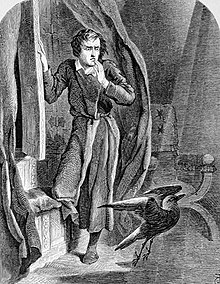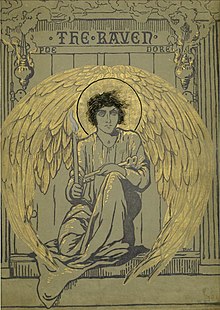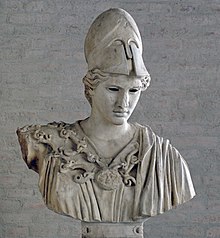The raven (Poe)

The Raven (in the English original The Raven ) is a narrative poem by the American writer Edgar Allan Poe . It was published for the first time on January 29, 1845 in the New York newspaper Evening Mirror and describes in 108 verses the mysterious midnight visit of a raven to a desperate man whose lover has died. It is one of the most famous American poems.
content

The lyrical narrator of the poem hears a gentle knock on the door one night while reading it. Deeply affected by the death of his lover Lenore , he has sought consolation in reading strange, possibly occult books, which have further strained his already irritable nerves. The dying of the fireplace and the rustling of the curtains accelerate his heartbeat; to calm himself down, he tells himself that the knock was only from a late visitor. But when he opens the door and there is no one there, the loss of his lover and the strange readings awaken the irrational hope in him that the knock could be from Lenore. When he returns to the room there is another knock, this time on the window. He opens it and a stately raven flies through the window into the room and sits on the bust of Pallas Athene .
The narrator asks the raven for his name, but the bird croaks "Nevermore" (original Nevermore ), whereupon the man tries to find out under what circumstances the raven learned this word and what he could mean by it. When asked to forget Lenore, the raven replied to a new "Nevermore" without being asked. This excites the narrator, and he asks the raven further questions: whether there is relief for his soul and whether he will meet Lenore in heaven . The raven answers both with “Nevermore”. Completely beside himself, the man asks the raven to leave him, but again the raven answers in the usual manner and does not leave the bust. The poem ends with the narrator or his soul lying in the shadow that the raven throws on the ground, and from there it will never rise again.
Origin and edition history
Poe knew demonstrably Charles Dickens ' novel Barnaby Rudge, in which the raven of tangled Barnaby, the word "Nobody" speak, Horace Smith 's novel Zillah in which a showman performs tricks with a raven, and Elizabeth Barrett Browning's poem Lady Geraldine's Courtship with the following refrain: “ Ever, evermore the while in a slow silence she kept smiling. " The name of the lost loved one at Poe, Lenore, is a reference to the then internationally still famous horror ballad Lenore of Gottfried August Bürger from the year 1774th
No other versions of Poe's poem have survived, so the creation can only be traced back to Poe's own statements. He worked on it for ten years, with interruptions, and so The Raven emerged from an originally planned short poem about an owl. In particular, in The Philosophy of Composition ( The Philosophy of Composition ) sets Poe, albeit gathered in time, the work process on the poem represents, emphasizing the full plan or even mathematical composition that should leave nothing to chance. In it he also emphasizes the meaning the raven actually has for him, namely as a "symbol of mournful and never-ending memory ".
It is believed that the last version was made in 1844. Poe offered it to Graham's Magazine in Philadelphia for publication, which however declined. The American Review in New York acquired the poem for its February issue in 1845, where it appeared under the pseudonym Quarles, an allusion to the English poet and emblematic artist Francis Quarles . The Evening Mirror got permission to publish it on January 29th. Both provided the poem with an appreciative preliminary remark. In the same year, The Raven was printed in numerous other newspapers and magazines and appeared in November 1845 as the title in Poe's collection of poems The Raven and Other Poems .
Since then, The Raven has been anthologized many times . Later prints were often provided with illustrations by well-known artists or illustrators. For example, the edition of the anthology The Poetical Works of Edgar Allan Poe: With Original Memoir, published in 1866 and 1871 by London's Sampson Low Verlag, contained various illustrations by John Tenniel , best known for his illustrations of Alice in Wonderland . An edition of the poem in New York's Harper & Brothers Verlag was illustrated in 1884 with woodcuts by the French painter and graphic artist Gustave Doré , which the latter completed before his death. In 1875, under the title Le Corbeau, a translation into French by Stéphane Mallarmé appeared , which, in addition to the original text, contained various lithographs by Édouard Manet to illustrate the poem. The Raven also provided the basis for a large number of other graphics, drawings and illustrations in the 20th century , for example by Edmund Dulac or István Orosz or Horst Janssen ( EA Poe - "never more" ).
Translations

The raven has been translated into many languages. The first “European” translation was a French one, published in the Journal d'Alençon on January 9, 1853 by an anonymous translator . In the same year the first translation by Charles Baudelaire , William Little Hughes and others followed.
The first German translation was made by Elise von Hohenhausen in 1853 and was published in the magazine for foreign literature . In 1856 another one by Alexander Neidhardt followed in the archive for the study of modern languages and literatures, and the following year that of Luise von Plönnies . Numerous other transmissions followed, including by Carl Theodor Eben (1864), Anna Vivanti-Lindau (1878), Hedwig Lachmann (1891), Theodor Etzel (1908), Otto F. Babler (1931), Hans Wollschläger (1966) and Christa Schuenke (1996).
The first stanza reads:
- Once upon a midnight dreary, while I pondered, weak and weary,
- Over many a quaint and curious volume of forgotten lore—
- While I nodded, nearly napping, suddenly there came a tapping,
- As of some one gently rapping, rapping at my chamber door.
- “'Tis some visitor,” I muttered, “tapping at my chamber door—
- Only this and nothing more. "
The transmission of Wollschläger begins with the words:
- Once, at midnight, grayish, when I thought gloomily and comfortably
- tired of many an old folio, long forgotten teaching -
- as sleep was already creeping up, suddenly a soft throbbing sounded,
- just like when a fingerbone throbbed from the door.
- “It's probably a visitor”, I grumble, “what's throbbing so bony to me -
- that alone - nothing more. "
The translation closest to the original version in terms of content and rhyme comes from Carl Theodor Eben , who translated the first verse as follows:
- Midnight surrounded me with horror when I was lonely, gloomy and sad,
- I sat pensively and read about some of the long-faded Morars and teaching -
- When, with dull eyes, I was about to nod to sleep,
- Suddenly I heard a ticking sound at the door of the room;
- “One more visit,” so I thought, “which chance brings here -
- One visit and nothing else. "
In Hedwig Lachmann's translation , the first stanza reads as follows:
- One night of yellow leaves with faded rune letters
- Searching for, collecting, from the seas of time,
- Looking tiredly into the lines and finally nodding in his sleep,
- Suddenly I heard knocking softly, knocking softly but audibly
- And started stammering in shock: "One of the comrades,
- One of the comrades! "
The German poet, writer and translator Maria Mathi made a transfer that was printed in 1954 in the collection "Thousand Mouths, European Ballads, Romances and Songs" published by Langewiesche-Brandt. The first verse of Mathis' transmission reads:
- When I once at witching hour, suffering from the wound of life,
- covered old customer wisdom, old wisdom teaching,
- when I, sleepy, could hardly stay awake any longer, knocked
- on the door it knocked softly, like a maid's desire.
- “Oh, there's another visitor coming”, I thought, “where does he come from?
- - still here late at night? "
Quotes
Often quoted verses:
- " Once upon a midnight dreary ... " (German: " Once upon a midnight grayish ...")
- " ... on the Night's Plutonian Shores ... " (German: "... in Pluto's night sphere ...")
- “ Quoth the raven: Nevermore. "(German:" Spoke the raven: Nevermore. ")
- “ And my soul from out that shadow that lies floating on the floor Shall be lifted — nevermore! "(German:" And my soul should rise from the shadow floating on the ground - never more. ")
- " Deep into the darkness peering, long I stood there, wondering, fearing, ... " (German: "Gloomy looking into the darkness, I stood rigid and dreadful ...")
reception
The poem has been widely received in literature and popular culture.
In Harry Mulisch's novel " The Discovery of Heaven " one of the main characters, Onno Quist, is holding a raven. He names the bird Edgar. His call is interpreted as “cras”, Latin for “tomorrow”. In Neil Gaiman's novel “ American Gods ”, one of Odin's ravens replied to the prompt “ Say 'Nevermore' ” with simply “ Fuck you ”. On Terry Pratchett's “ Discworld ” there is “Sprach, der Rabe” (orig. “Quoth, the raven”), who does not want to pronounce the “N-word”.
The American football team of the city of Baltimore , Maryland, which plays in the National Football League , was named Baltimore Ravens when it was founded on March 29, 1996 , in honor of Edgar Allan Poe, who died in Baltimore, after his poem "The Raven". Until the end of the 2008 season, the costumed ravens Edgar, Allan and Poe were the team's official mascots.
In 1998 a cartoon adaptation of the poem was made. The Coen brothers used the poem in Ladykillers as a common thread. Motifs from the poem are built into the entire film and especially in the final scene. In the first "Treehouse of Horror" episode (Season 2, Episode 3) of the Simpsons , Lisa reads the poem out as a horror story. Homer appears in the role of the narrator (originally spoken by James Earl Jones ), Bart in the role of the raven, Maggie and Lisa as angel and Marge as Lenore in the form of two oil paintings. In the film The Crow , the main character Eric Draven quotes part of the poem. In Jacques Rivette's film The Story of Marie and Julien , Julien's cat is called Nevermore. In the series The Munsters there is a raven in the cuckoo clock who keeps saying "Nevermore".
In 1963, the American B-film director Roger Corman filmed the poem under the title The Raven (German Der Rabe - Duell der Zauberer ) as an absurd fantasy comedy with a cast of the classic horror film actors Vincent Price , Peter Lorre , Boris Karloff and among others the young Jack Nicholson .
In 2012, directed by James McTeigue , The Raven - Prophet of the Devil, a fictional film adaptation of the last days of Poe's life, the title of which comes from the poem. However, apart from ravens as a recurring film element, the film has nothing in common with the poem. The male lead took over John Cusack .
Probably the Polish composer Eugeniusz Morawski-Dąbrowa (1876–1948), who emigrated to Paris between 1907 and 1930, was the first to set the poem to music in 1911 under the title “Nevermore”. The expressive 17-minute orchestral work was first performed in Warsaw in 1924; it had to be reconstructed after the Second World War, as parts of the original score were burned in 1944 when the German Wehrmacht put down the Warsaw Uprising .
“Der Rabe” was set to music by The Alan Parsons Project on the album “ Tales of Mystery and Imagination ” and by the group Omnia on the album “Alive!”. Even Gregorian , Lou Reed , Grave Digger (on the album "The Grave Digger"), Rotting Christ and Tristania processed the poem musically. The famous Hard Style - DJ Pavo processes the poem in its tracks "Raven". The Swiss folk metal band Eluveitie processed the poem in their song “Quoth the raven” from the album “ Everything Remains as It Never Was ”. The Japanese composer Toshio Hosokawa composed it as "The Raven - Monodrame pour mezzo-soprano et ensemble de 12 musiciens", premiered in June 2012, in concert in Brussels and as a staged version in Luxembourg.
The American professional wrestler Scott Levy builds his wrestling gimmick partly on this poem and mainly uses the phrase “Quoth, the raven: Nevermore”.
The short film Vincent (1982) by Tim Burton also builds on the poem and ends with its final line.
The video game Eternal Darkness: Sanity's Requiem begins with the quote “Deep into that darkness peering, long I stood there wondering, fearing, doubting…” (fifth stanza).
In the German versions of the Donald Duck comics, the raven of the witch Gundel Gaukeley bears the name Nevermore (orig. “Ratface”, literally: “Ratface”), based on Poe's poem .
The cabaret artist Michael Feindler parodied the poem with a poem “Die Elster” with the recurring words “more and more”.
Web links
- Le Corbeau / The Raven with illustrations by Édouard Manet , edition from 1875 . On: Project Gutenberg .
- The Raven with illustrations by Gustave Doré, 1884 edition . On: Project Gutenberg .
- Edition with the Doré illustrations
- The raven as a cartoon from 1998
- The raven with illustrations
- (Ogg, 4.2 MiB)
- Song version ( MP3 , 7.8 MiB)
Individual evidence
- ↑ The entire work in ten volumes, Vol. 10, 1976, p. 548.
- ↑ For the entire genesis and edition history, see the notes on the poem in: Der Rabe. Poems & essays , collected works in 5 volumes, translated by Arno Schmidt , Hans Wollschläger, Friedrich Polakovics and Ursula Wernicke. Zurich: Haffmans, 1994, pp. 443-447.
- ↑ William T. Bandy: Tentative Checklist of Translations of Poe's Works (1844-1899) on eapoe.org
- ↑ Erika Hulpke: On First Translations of “The Raven” into German. In: Poe Studies. Volume XV, Number 2 (December 1982), p. 41.
- ↑ Magazine for the Literature of Foreign Countries, No. 70, June 11, 1853, p. 280.
- ↑ Archives for the Study of Modern Languages and Literatures, Volume 19, Westermann, Braunschweig 1856, pp. 185–187.
- ↑ Magazine for Foreign Literature, No. 130, October 29, 1857, pp. 519-520.
- ^ Wikisource
- ^ Wikisource
- ↑ Naming Baltimore's Team: Ravens. (No longer available online.) In: www.baltimoreravens.com. Archived from the original on July 8, 2016 ; accessed on December 25, 2013 . Info: The archive link was inserted automatically and has not yet been checked. Please check the original and archive link according to the instructions and then remove this notice.
- ↑ German translation of the poem in the Simpsons episode 7F04
- ↑ Information from: CD booklet for CD: "poland abroad - symphonic poems", 2007 by EDA Edition Abseits, a label of KLASSIK CENTER KASSEL Glöcknerpfad 47, D-34134 Kassel, www.eda-records.de, EDA 27, ISRC: DE73-06-0015-1 to 7, LC 06597. See also the information on the website of allmusic.com: Review by James Leonard . Retrieved January 14, 2014.
- ^ Rotting Christ - The Raven (by Edgar Allan Poe). Retrieved September 7, 2019 .
- ↑ Donald Duck and Mickey Mouse Wiki - Gundel Gaukeley . On: Wikia online. Retrieved February 10, 2014.
- ↑ Michael Feindler: Stupid nods well. 2nd edition, Berlin 2013. ISBN 978-3-00-041445-9 . P. 62ff.


